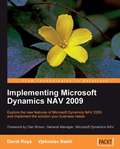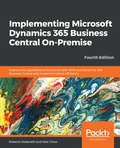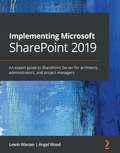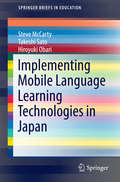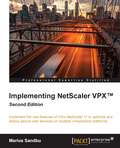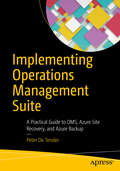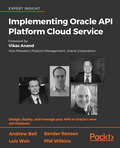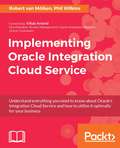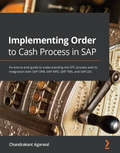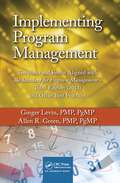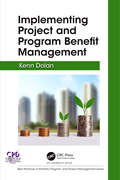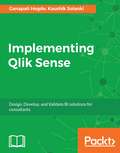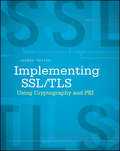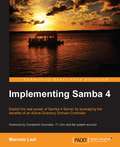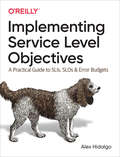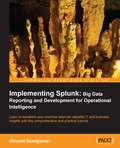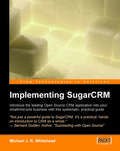- Table View
- List View
Implementing Microsoft Dynamics NAV 2009
by Vjekoslav Babi David RoysWritten in an easy-to-read style, this book is a refreshing alternative to the official Microsoft training and reference material which, although comprehensive, can sometimes be tiring to read. This is not a reference book, although you may find you refer to it often, giving you access to years of experience in implementing and programming Dynamics NAV. You will learn all the new features in NAV 2009, without needing to invest significant study time.Dynamics NAV implementation consultants and developers that want to quickly understand the new features offered in the 2009 release.NAV consultants that want to learn more about programming and extensibility without needing to learn a programming language will also benefit from this book.NAV programmers that want to learn about finance configuration and solution design in order to be a better programmer and design better solutions can also use this book.
Implementing Microsoft Dynamics NAV 2013
by Laura Nicolàs Lorente Cristina Nicolàs LorenteThis book is step-by-step guide to implementing Dynamics NAV from start to finish.If you are new to Dynamics NAV or have been implementing it for a while, the book will lead you from start to finish, teaching you how to deploy valuable implementations. This book is also for Dynamics NAV implementation consultants, project managers, and developers that want to get a deep view of what Dynamics NAV 2013 can offer, as well as NAV developers that want to learn more about the whole application. IT managers considering the implementation of Dynamics NAV 2013 in their organizations will fully understand what to expect and how to accomplish it upon reading this book
Implementing Microsoft Dynamics NAV and Business Central - Fourth Edition
by Alex Chow Roberto StefanettiThis book is for Dynamics NAV partners and end users who want to know everything about Dynamics NAV implementations. It is aimed at those who want to be project managers or get involved with Dynamics NAV, but do not have the expertise to write code themselves. This book can be useful to understand the need to move to Business Central.
Implementing Microsoft SharePoint 2019: An expert guide to SharePoint Server for architects, administrators, and developers
by Lewin Wanzer Angel WoodBring on-premise and cloud collaboration features to life with Microsoft's enterprise content management platform - SharePoint ServerKey FeaturesGet up to speed with the latest version of SharePoint and make the most of its featuresSet up and effectively manage your SharePoint Farm in the cloud or on premiseLearn how to align your development tools and cloud infrastructure to support collaborationBook DescriptionMicrosoft's latest addition to their product range, SharePoint Server 2019, is a new enterprise content management platform that brings on-premise collaboration features to life. It can be used as an isolated platform or in a hybrid connected configuration providing management and connectivity to Office 365. You can use the SharePoint framework to host sites, information, data, and applications in a robust CMS that centralizes collaborative content for enterprises. SharePoint 2019 enables new integrations and features that will allow you to work seamlessly with new and old Office products such as Microsoft Power Apps and other Microsoft Office applications. Implementing Microsoft SharePoint 2019 will help you understand the challenges, planning, migration steps, installation concepts, and configuration involved in providing this platform for your enterprise. The book will also show you what the platform brings to the table from an on-premise server perspective. If you're new to SharePoint 2019, you'll also be guided through how to get servers up and running so that you and your user community can become productive with this powerful new platform. By the end of this book, you'll be well-versed in Microsoft SharePoint 2019 and have the knowledge you need to apply your skills in the real world.What you will learnUnderstand changes to the platform and how to migrate from other versions of SharePointExplore infrastructure planning and governance relating to collaborative environmentsInstall and configure network components, servers, and desktopsUse SharePoint services and other Microsoft product servers and appsMonitor and troubleshoot SharePoint after it is implementedDiscover the tools that can be used with SharePoint 2019 for BI and reportingDelve into social features and collaborationMaintain, monitor, and support the rollout of the platform in your enterpriseWho this book is forThe book is for SharePoint administrators, developers, and architects who have some experience in designing, planning, implementing, and managing SharePoint Farms.
Implementing Mobile Language Learning Technologies in Japan
by Steve Mccarty Hiroyuki Obari Takeshi SatoThis book explores theoretical and practical aspects of implementing mobile language learning in university classrooms for English as a Foreign Language in Japan. The technologies utilized, such as smartphones, iPads, and wi-fi, integrate students' hand-held devices into the campus network infrastructure. The pedagogical aims of ubiquitous mobile learning further incorporate social media, blended learning, and flipped classroom approaches into the curriculum. Chapter 1 defines mobile language learning within dimensions of e-learning and technology-assisted language learning, prior to tracing the development of mobile learning in Japan. Chapter 2 documents the sociocultural theory underpinning the authors' humanistic approach to implementation of mobile technologies. The sociocultural pedagogy represents a global consensus of leading educators that also recognizes the agency of Asian learners and brings out their capability for autonomous learning. Case studies of universities, large and small, public and private, are organized similarly in Chapters 3 to 5. Institutional/pedagogical and technological context sections are followed by detailed content on the implementation of initiatives, assessment of effectiveness, and recommendations for other institutions. Distinct from a collection of papers, this monograph tells a story in brief book length about theorizing and realizing mobile language learning, describing pioneering and original initiatives of importance to practitioners in other educational contexts.
Implementing Modern DevOps
by David GonzalezHelp your organization join the DevOps revolution About This Book • Helps you skill up your DevOps knowledge without a strong set of prerequisites • Deliver continuously improved software by showcasing the most advanced tools and techniques • Acquire a deeper insight into implementing DevOps in your organization and deliver results from day 1 Who This Book Is For This book is written for engineers and companies that want to learn the minimum set of required technologies and processes to be successful in the DevOps world. This book also targets system administrators, developers, and IT professionals who would like to employ DevOps techniques and best practices to manage IT infrastructures or would like to acquire the necessary skills needed to work in DevOps teams. What You Will Learn • Master development best practices. • Understand how the Agile Delivery Methodology helps you ensure accuracy and quality. • Analyze branching strategies such as branch creation, merging, and synchronization. • Learn to automate builds to deploy and deliver code faster and more often • Explore testing frameworks and how to automate testing • Learn to put specific metrics in place to measure ROI of DevOps and monitor logs and events in a system In Detail This book follows a unique approach to modern DevOps using cutting-edge tools and technologies such as Ansible, Kubernetes, and Google Cloud Platform. This book starts by explaining the organizational alignment that has to happen in every company that wants to implement DevOps in order to be effective, and the use of cloud datacenters in combination with the most advanced DevOps tools to get the best out of a small team of skilled engineers. It also delves into how to use Kubernetes to run your applications in Google Cloud Platform, minimizing the friction and hassle of maintaining a cluster but ensuring its high availability. By the end of this book, you will be able to realign teams in your company and create a Continuous Delivery pipeline with Kubernetes and Docker. With strong monitoring in place, you will also be able to react to adverse events in your system, minimizing downtime and improving the overall up-time and stability of your system. Style and approach This book takes a step-by-step practical approach to the implementation of DevOps. This book will teach you how to enable IT organizations to deliver faster and smarter through a unique approach using Code-Build-Test-Release-Configure-Monitor (CBTRCM).
Implementing NetScaler VPX™
by Marius SandbuAn easy-to-follow guide with detailed step-by step-instructions on how to implement the different key components in NetScaler, with real-world examples and sample scenarios. If you are a Citrix or network administrator who needs to implement NetScaler in your virtual environment to gain an insight on its functionality, this book is ideal for you. A basic understanding of networking and familiarity with some of the different Citrix products such as XenApp or XenDesktop is a prerequisite.
Implementing NetScaler VPX™ - Second Edition
by Marius SandbuThis book is for Citrix administrators who are just getting started with NetScaler, have some basic networking skills This book does not require prior experience of NetScaler.
Implementing OpenShift
by Adam MillerA standard tutorial-based approach to using OpenShift and deploying custom or pre-built web applications to the OpenShift Online cloud.This book is for software developers and DevOps alike who are interested in learning how to use the OpenShift Platform-as-a-Service for developing and deploying applications, how the environment works on the back end, and how to deploy their very own open source Platform-as-a-Service based on the upstream OpenShift Origin project.
Implementing Operations Management Suite
by Peter De TenderLearn how to protect, back up, recover, and monitor your data and infrastructure in the cloud with Microsoft's Operations Management Suite (OMS), Azure Backup, and Azure Site Recovery.Implementing Operations Management Suite starts with an overview of the Operations Management Suite, followed by an introduction to Azure virtual machines and virtual networks. Chapters cover Azure Backup and how to configure it, followed by deep dives into aspects of Azure Site Recovery (ASR): how it works, how to configure it, how to streamline your disaster recovery failover from on-premises to Azure, and so on. Learn about protection groups, how to perform planned and unplanned failover, and more. Windows IT pro consultant, trainer and MVP Peter De Tender takes you through the necessary theory and background on each topic along with hands-on step-by-step lab guides to help you implement and configure each feature for yourself. You’ll also find out how to estimate your platform costs when using Azure infrastructure components, making this book your one-stop guide to the latest disaster recovery services in Microsoft Azure. What You'll LearnUnderstand current concepts and challenges in IT disaster recoveryGet introduced to Microsoft Azure, Azure virtual networks and Azure virtual machinesProtect your data in the cloud with Azure Backup, and the configuration options availableUnderstand how to protect, recover, and monitor your environment with Azure Site Recovery Manager, and the configuration options availableExtend Azure Site Recovery Manager to non-Hyper-V workloadsWho This Book Is ForIT professionals and IT decision makers who are interested in learning about Azure backup and Azure Site Recovery Manager in order to build and/or optimize their IT disaster recovery scenarios.
Implementing Oracle API Platform Cloud Service: Design, deploy, and manage your APIs in Oracle’s new API Platform
by Andrew Bell Phil Wilkins Sander Rensen Luis WeirWork with the newest Oracle API Platform Cloud Service to interface with the increasingly complex array of services your clients want.Key Features Understand the architecture and functionality of the new Oracle API Cloud Service Platform Understand typical use cases for the new platform and how it can work for you Design your own APIs, then deploy and customize your APIs Implement Oauth 2.0 policy and custom policies Migrate from Oracle 12c solutions to the new Oracle API platformBook DescriptionImplementing Oracle API Platform Cloud Service moves from theory to practice using the newest Oracle API management platform. This critical new platform for Oracle developers allows you to interface the complex array of services your clients expect in the modern world.First, you'll learn about Oracle’s new platform and get an overview of it, then you'll see a use case showing the functionality and use of this new platform for Oracle customers. Next, you’ll see the power of Apiary and begin designing your own APIs. From there, you’ll build and run microservices and set up the Oracle API gateways. Moving on, you’ll discover how to customize the developer portal and publish your own APIs. You’ll spend time looking at configuration management on the new platform, and implementing the Oauth 2.0 policy, as well as custom policies. The latest finance modules from Oracle will be examined, with some of the third party alternatives in sight as well.This broad-scoped book completes your journey with a clear examination of how to transition APIs from Oracle API Management 12c to the new Oracle API Platform, so that you can step into the future confidently.What you will learn Get an overview of the Oracle API Cloud Service Platform See typical use cases of the Oracle API Cloud Service Platform Design your own APIs using Apiary Build and run microservices Set up API gateways with the new API platform from Oracle Customize developer portals Configuration management Implement Oauth 2.0 policies Implement custom policies Get a policy SDK overview Transition from Oracle API Management 12c to the new Oracle API platformWho this book is forThis book is for all Oracle developers who are working or plan to work with the Oracle API Platform Cloud Service.
Implementing Oracle Integration Cloud Service
by Phil Wilkins Robert Van MolkenUnderstand everything you need to know about Oracle's Integration Cloud Service and how to utilize it optimally for your business About This Book • The only guide to Integration Cloud Service in the market • Focused on practical action to deliver business value • A professional's guide to an expensive product, providing comprehensive training, and showing how to extract real business value from the product Who This Book Is For This book is ideal for any IT professional working with ICS, any Oracle application or cloud solution developer or analyst who wants to work with ICS to deliver business value. What You Will Learn • Use ICS to integrate different systems together without needing to be a developer • Gain understanding of what a number of technologies and standards provide – without needing to understand the fine details of those standards and technologies • Understand the use of connectors that Oracle provide from technology based connections such as file and database connections to SaaS solutions ranging from Salesforce to Twitter • Enrich data and extend SaaS integration to route to different instances • Utilize a number of tools to help develop and check that your integrations work before connecting to live systems • Introduce and explain integration concepts so that the integrations created are maintainable and sustainable for the longer term • Provide details on how to keep up to date with the features that Oracle and partners provide in the future • Get special connections developed to work with ICS In Detail Businesses are built on data, and applications that access that data. In modern businesses the same cloud-based data stores and applications might be accessed by hundreds of different applications from thousands of different devices via APIs. To make this happen, APIs must be wired together i.e. integrated. Oracle Integration Cloud Service provides a complete method for integrating enterprise applications in the cloud. Integration Cloud Service (ICS) provides a cloud hosted means to integrate systems together using a graphical means to define and represent integrations. This book will be a comprehensive, hands-on guide to building successful, high-availability integrations on ICS. This book sets out to demonstrate how ICS can be used to effectively implement integrations that work both in the cloud and on premise. It starts with a fast, practical introduction to what ICS can do for your business and then shows how ICS allows you to develop integrations not only quickly but in a way that means they are maintainable and extensible. Gradually it moves into more advanced integrations, showing how to achieve sophisticated results with ICS and work with external applications. Finally the book shows you how to monitor cloud apps and go beyond ICS to build even more powerful integrated applications. By the end of the book, you will the knowledge on how to use ICS to solve your own integration needs and harness the technologies in a maintainable and sustainable manner. Style and approach This book will take a pragmatic approach and will be a business-focused guide to delivering business value with ICS.
Implementing Order to Cash Process in SAP: An end-to-end guide to understanding the OTC process and its integration with SAP CRM, SAP APO, SAP TMS, and SAP LES
by Chandrakant AgarwalImplement critical business processes with mySAP Business Suite to integrate key functions that add value to every facet of your organizationKey FeaturesLearn master data concepts and UI technologies in SAP systemsExplore key functions of different sales processes, order fulfillment options, transportation planning, logistics execution processes, and customer invoicingConfigure the Order to Cash process in SAP systems and apply it to your business needsBook DescriptionUsing different SAP systems in an integrated way to gain maximum benefits while running your business is made possible by this book, which covers how to effectively implement SAP Order to Cash Process with SAP Customer Relationship Management (CRM), SAP Advanced Planning and Optimization (APO), SAP Transportation Management System (TMS), SAP Logistics Execution System (LES), and SAP Enterprise Central Component (ECC). You'll understand the integration of different systems and how to optimize the complete Order to Cash Process with mySAP Business Suite. With the help of this book, you'll learn to implement mySAP Business Suite and understand the shortcomings in your existing SAP ECC environment. As you advance through the chapters, you'll get to grips with master data attributes in different SAP environments and then shift focus to the Order to Cash cycle, including order management in SAP CRM, order fulfillment in SAP APO, transportation planning in SAP TMS, logistics execution in SAP LES, and billing in SAP ECC. By the end of this SAP book, you'll have gained a thorough understanding of how different SAP systems work together with the Order to Cash process. What you will learnDiscover master data in different SAP environmentsFind out how different sales processes, such as quotations, contracts, and order management, work in SAP CRMBecome well-versed with the steps involved in order fulfillment, such as basic and advanced ATP checks in SAP APOGet up and running with transportation requirement and planning and freight settlement with SAP TMSExplore warehouse management with SAP LES to ensure high transparency and predictability of processesUnderstand how to process customer invoicing with SAP ECCWho this book is forThis book is for SAP consultants, SME managers, solution architects, and key users of SAP with knowledge of end-to-end business processes. Customers operating SAP CRM, SAP TMS, and SAP APO as part of daily operations will also benefit from this book by understanding the key capabilities and integration touchpoints. Working knowledge of SAP ECC, SAP CRM, SAP APO, SAP TMS, and SAP LES is necessary to get started with this book.
Implementing Program Management: Templates and Forms Aligned with the Standard for Program Management, Third Edition (2013) and Other Best Practices (Best Practices And Advances In Program Management Ser. #6)
by Ginger Levin Allen R. GreenSuccess in program management requires discipline, complete plans, well-run meetings, accurate record keeping, and adherence to global best practices. Implementing Program Management: Templates and Forms Aligned with the Standard for Program Management, Third Edition (2013) and Other Best Practices provides the templates and guidelines for the plan
Implementing Project and Program Benefit Management (Best Practices in Portfolio, Program, and Project Management)
by Kenn DolanOne of the most difficult, yet important, questions regarding projects is "What advantages will this project create for the investors and key stakeholders?" Projects and programs should be treated as investments. This means that the focus of projects shifts from delivering within the triple constraints (time–cost–quality) towards some of the more fundamental questions: <P><P> <li>What is the purpose of this investment? <li>What are the specific advantages expected? <li>Are these benefits worth the investment? <P><P>Implementing Project and Program Benefit Management is written for executives and practitioners within the portfolio, program, and project environment. It guides them through the important work that must be addressed as the investment progresses towards the realization of benefits. The processes discussed cover the strategic elements of benefits realization as well as the more detailed requirements, which are the domain of the program delivery teams and the operational users. Using real cases to explain complex situations, operational teams and wider groups of stakeholders, including communities affected by infrastructure projects, will be able to engage in the conversation with the sponsors and delivery teams. <P><P>Covering an area of program and project management that is rapidly becoming more widely valued, this book blends theory with practical experience to present a clear process flow to managing the benefits life cycle. Best practices are defined, and pitfalls and traps are identified to enable practitioners to apply rigor and structure to this crucial discipline.
Implementing Qlik Sense
by Ganapati Hegde Kaushik SolankiBecome a full-fledged Qlik Sense Consultant with the help of this unique guide About This Book • Become a successful Qlik consultant with the help of this insightful guide • Build what is in line as well as exceeding your customer's expectations from your Qlik Sense solutions using this highly practical guide • Build result-driven optimized BI solutions using Qlik with the help of industry examples Who This Book Is For If you have basic familiarity with Qlik Sense and want to upgrade your skills to become a full-fledged Qlik Consultant, this book is for you. With this book, you will be able to create efficient business intelligence solutions that would fetch client satisfaction, and in turn, more projects. What You Will Learn • Understand the importance and expectations of a consultant's role • Engage with the customer to understand the ir goals and future objectives • Design the optimum architecture, using the best practices for the development and implementation of your projects • Ensure successful adoption using real-life examples to make your learning complete • Learn about the important stages of a Qlik project's life cycle In Detail Qlik Sense is a leading platform for business intelligence (BI) solutions. Qlik Sense helps organizations in making informed decisions based on the data they have. This book will teach you how to effectively use Qlik for optimum customer satisfaction. You will undergo a metamorphosis from a developer to a consultant who is capable of building the most suitable BI solutions for your clients. The book will take you through several business cases – this will give you enough insight to understand the needs of the client clearly and build a BI solution that meets or exceeds their expectations. Starting from the pre-project activities, you will go to the actual execution of the project, the implementation, and even maintenance. This book will give you all the information you need - from the strategy to requirement gathering to implementing BI solutions using Qlik Sense. The book will empower you to take the right decisions in tricky and diffi cult situations while developing analytics and dashboards. Style and approach This book will be a hands-on guide that will teach you all the what-to-do's, when-to-do's, and how-to-do's for becoming a successful Qlik Sense Consultant. With the help of various business scenarios, the book will cover real-world problems that you can relate to. Various solutions in the book will be backed up by the thought process of why are these solutions used and how you can implement them in your own business environment.
Implementing SAP CRM: The Guide for Business and Technology Managers
by Vivek KaleIn today's competitive business environment, most companies realize that the better they can manage their customer relationships, the more successful they will become. Customer Relationship Management (CRM) software systems are key tools for companies to manage the customer-facing processes of their businesses. However, many companies have resisted
Implementing SAP S/4HANA: A Framework for Planning and Executing SAP S/4HANA Projects
by Sanket KulkarniGain a better understanding of implementing SAP S/4HANA-based digital transformations. This book helps you understand the various components involved in the planning and execution of successful SAP S/4HANA projects. Learn how to ensure success by building a solid business case for SAP S/4HANA up front and track business value generated throughout the implementation. Implementing SAP S/4HANA provides a framework for planning and executing SAP S/4HANA projects by articulating the implementation approach used by different components in SAP S/4HANA implementations. Whether you are mid-way through the SAP S/4HANA program or about to embark on it, this book will help you throughout the journey. If you are looking for answers on why SAP S/4HANA requires special considerations as compared to a traditional SAP implementation, this book is for you.What You Will LearnUnderstand various components of your SAP S/4HANA projectForecast and track your success throughout the SAP S/4HANA implementationBuild a solid business case for your SAP S/4HANA programDiscover how the implementation approach varies across these componentsWho This Book Is ForSAP S/4HANA clients (line managers and consultants).
Implementing SSL / TLS Using Cryptography and PKI
by Joshua DaviesHands-on, practical guide to implementing SSL and TLS protocols for Internet securityIf you are a network professional who knows C programming, this practical book is for you. Focused on how to implement Secure Socket Layer (SSL) and Transport Layer Security (TLS), this book guides you through all necessary steps, whether or not you have a working knowledge of cryptography. The book covers SSLv2, TLS 1.0, and TLS 1.2, including implementations of the relevant cryptographic protocols, secure hashing, certificate parsing, certificate generation, and more. Coverage includes:Understanding Internet Security Protecting against Eavesdroppers with Symmetric Cryptography Secure Key Exchange over an Insecure Medium with Public Key Cryptography Authenticating Communications Using Digital Signatures Creating a Network of Trust Using X.509 Certificates A Usable, Secure Communications Protocol: Client-Side TLS Adding Server-Side TLS 1.0 Support Advanced SSL Topics Adding TLS 1.2 Support to Your TLS Library Other Applications of SSL A Binary Representation of Integers: A Primer Installing TCPDump and OpenSSL Understanding the Pitfalls of SSLv2Set up and launch a working implementation of SSL with this practical guide.
Implementing Samba 4
by Marcelo LealThis book is an implementation tutorial covering step-by-step procedures, examples, and sample code, and has a practical approach to set up a Samba 4 Server as an Active Directory Domain Controller and also set up different Samba 4 server roles. This book is ideal for system administrators who are new to the Samba 4 software, and who are looking to get a good grounding in how to use Samba 4 to implement Active Directory Services. It's assumed that you will have some experience with general system administration, Active Directory, and GNU/Linux systems. Readers are expected to have some test machines (virtual machines), which will be used to execute the examples within this book.
Implementing Service Level Objectives: A Practical Guide To Slis, Slos, And Error Budgets
by Alex HidalgoAlthough service-level objectives (SLOs) continue to grow in importance, there’s a distinct lack of information about how to implement them. Practical advice that does exist usually assumes that your team already has the infrastructure, tooling, and culture in place. In this book, recognized SLO expert Alex Hidalgo explains how to build an SLO culture from the ground up.Ideal as a primer and daily reference for anyone creating both the culture and tooling necessary for SLO-based approaches to reliability, this guide provides detailed analysis of advanced SLO and service-level indicator (SLI) techniques. Armed with mathematical models and statistical knowledge to help you get the most out of an SLO-based approach, you’ll learn how to build systems capable of measuring meaningful SLIs with buy-in across all departments of your organization.Define SLIs that meaningfully measure the reliability of a service from a user’s perspectiveChoose appropriate SLO targets, including how to perform statistical and probabilistic analysisUse error budgets to help your team have better discussions and make better data-driven decisionsBuild supportive tooling and resources required for an SLO-based approachUse SLO data to present meaningful reports to leadership and your users
Implementing Splunk 7, Third Edition: Effective Operational Intelligence To Transform Machine-generated Data Into Valuable Business Insight, 3rd Edition
by James D. MillerThis book will help you implement Splunk 7's new services and will show you how to utilize them to quickly and efficiently process machine-generated big data. You will explore Splunk Cloud and the Machine Learning Toolkit and use them with ease throughout your organization. By the end of the book, you will have learned to implement these services in your tasks at work.
Implementing Splunk 7, Third Edition: Effective operational intelligence to transform machine-generated data into valuable business insight, 3rd Edition
by James D. MillerA comprehensive guide to making machine data accessible across the organization using advanced dashboards Key FeaturesEnrich machine-generated data and transform it into useful, meaningful insightsPerform search operations and configurations, build dashboards, and manage logsExtend Splunk services with scripts and advanced configurations to process optimal resultsBook DescriptionSplunk is the leading platform that fosters an efficient methodology and delivers ways to search, monitor, and analyze growing amounts of big data. This book will allow you to implement new services and utilize them to quickly and efficiently process machine-generated big data. We introduce you to all the new features, improvements, and offerings of Splunk 7. We cover the new modules of Splunk: Splunk Cloud and the Machine Learning Toolkit to ease data usage. Furthermore, you will learn to use search terms effectively with Boolean and grouping operators. You will learn not only how to modify your search to make your searches fast but also how to use wildcards efficiently. Later you will learn how to use stats to aggregate values, a chart to turn data, and a time chart to show values over time; you'll also work with fields and chart enhancements and learn how to create a data model with faster data model acceleration. Once this is done, you will learn about XML Dashboards, working with apps, building advanced dashboards, configuring and extending Splunk, advanced deployments, and more. Finally, we teach you how to use the Machine Learning Toolkit and best practices and tips to help you implement Splunk services effectively and efficiently. By the end of this book, you will have learned about the Splunk software as a whole and implemented Splunk services in your tasks at projectsWhat you will learnFocus on the new features of the latest version of Splunk Enterprise 7Master the new offerings in Splunk: Splunk Cloud and the Machine Learning ToolkitCreate efficient and effective searches within the organizationMaster the use of Splunk tables, charts, and graph enhancementsUse Splunk data models and pivots with faster data model accelerationMaster all aspects of Splunk XML dashboards with hands-onapplicationsCreate and deploy advanced Splunk dashboards to share valuable business insights with peers Who this book is forThis book is intended for data analysts, business analysts, and IT administrators who want to make the best use of big data, operational intelligence, log management, and monitoring within their organization. Some knowledge of Splunk services will help you get the most out of the book
Implementing Splunk: Big Data Reporting and Development for Operational Intelligence
by Vincent BumgarnerA practical Tutorial,The book targets professionals and organizations who want to implement or have already implemented Splunk for log analysis and indexing. Analysts and IT staff for end-to-end investigation, performance monitoring etc will also learn from the practical examples. It would even help Managers to build reports and summarize the health, performance, and activity of their IT infrastructure and business. You will also find it helpful as a technical administrator, consultant or end user,Some basic knowledge about Splunk would be helpful, but not necessary.
Implementing SugarCRM
by Michael J.R. WhiteheadUsing a unique checklist approach the book works from the SugarCRM basics right up to advanced features in a clear, friendly way. It is carefully designed to distil hard-won SugarCRM wisdom from a recognized expert into a clear, readable, practical guide. By helping you clarify your business goals the book enables you to build a CRM system to support your business needs, and shows SugarCRM in a realistic business setting through an Extended case study. Small-medium business owners/managers with reasonable IT skills, who want to implement SugarCRM for themselves as either a first CRM or as a replacement for existing solutions. IT staff tasked with implementing, maintaining, or upgrading a SugarCRM installation Existing SugarCRM users who want to broaden their understanding of the topic No programming knowledge is required to use this book to implement, customise and use SugarCRM
